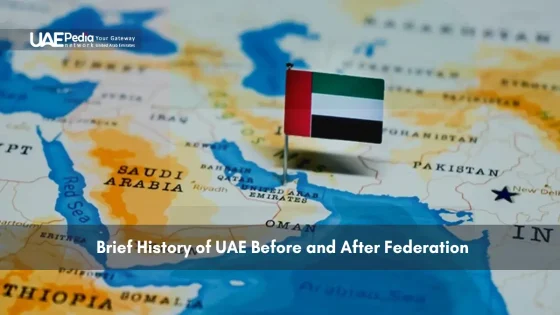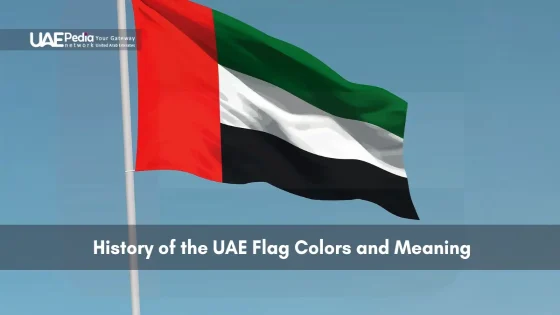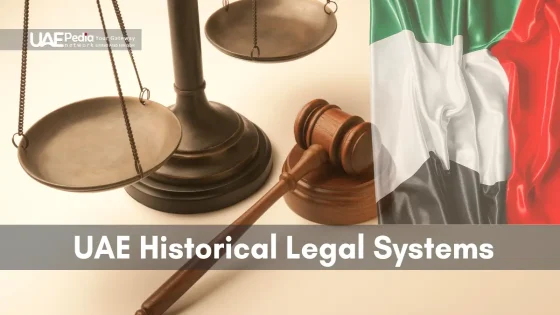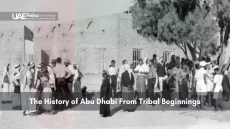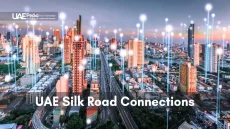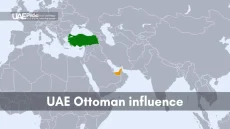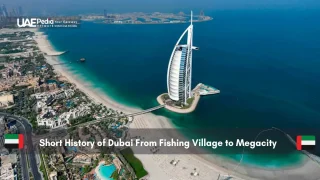We often picture the UAE as a young nation of glittering skyscrapers. But what if its story stretches back 125,000 years? Long before oil tankers and metro lines, ancient traders navigated these shores, exchanging pearls and pottery across continents.
The region we now call the United Arab Emirates thrived as a crossroads of civilizations. Medieval ports buzzed with merchants from Mesopotamia to India. By the 19th century, coastal settlements evolved into the Trucial States – a network of sheikhdoms balancing pearl diving, fishing, and growing British influence.
Everything changed when seven emirates united in 1971. This wasn’t just political teamwork. It was the culmination of shared desert wisdom, maritime traditions, and a collective vision for sovereignty. Today’s ultramodern cities stand on foundations of Bedouin resilience and seafaring innovation.
Key takeaways:
- Discover 125 millennia of human activity, from Stone Age tools to space-age ambitions
- Trace how coastal trade routes shaped the region’s identity long before federation
- Understand the pivotal shift from British-protected Trucial States to unified nation
Ancient Foundations and Early Settlements
Beneath Abu Dhabi’s gleaming towers lie secrets older than the pyramids. This region thrived as a cultural crossroads long before modern borders existed. Let’s dust off the sand to reveal civilizations that shaped the area’s DNA.
The Magan Civilization and Umm Al Nar Culture
Around 5,000 years ago, the Magan people turned this arid landscape into a hub of innovation. Their copper mines fueled trade with Mesopotamia and the Indus Valley – think Bronze Age supply chains! Archaeologists still marvel at their underground irrigation systems, called aflaj, that made desert agriculture possible.
The Umm Al Nar culture left even more visible marks. On Abu Dhabi’s eastern edge, their circular stone tombs resemble giant stone puzzles. These burial sites, packed with pottery and jewelry, whisper stories of social hierarchy and spiritual beliefs. One tomb alone held remains of 600 individuals – talk about community real estate!
Trade Routes and Archaeological Discoveries
Coastal sites like Ed-Dur reveal how early Emiratis mastered maritime trade. Imagine docks bustling with frankincense, dates, and pearls bound for Rome and Persia. Recent digs at Mleiha uncovered a 2,000-year-old settlement complete with fortifications – you can almost hear ancient merchants haggling over camel caravans.
Want to walk these ancient paths? The strategic coastal forts near Dibba showcase how communities protected their precious trade networks. Each pottery shard and bronze arrowhead found here rewrites what we know about the area’s role in global history.
From the Bronze Age to Iron Age Innovations
Imagine holding a 4,000-year-old dagger forged from ores traded across ancient seas. This region’s artisans didn’t just adapt to their environment—they reinvented it. Coastal communities transformed raw materials into coveted goods, sparking technological leaps that echo in today’s skylines.
Key Archaeological Sites in the Bronze Age
At Ed-Dur near Umm Al Quwain, archaeologists uncovered a bustling port city. Picture merchants bartering Dilmun pottery from Bahrain for copper tools made in Magan. Over 500 tombs here reveal burial goods from as far as Rome—proof of a trade network spanning continents.
Tell Abraq tells another story. This fortified settlement near Sharjah boasted circular towers and advanced metallurgy workshops. Farmers here grew dates using irrigation canals while smiths crafted bronze spearheads—tools that powered regional economies for centuries.
| Period | Innovation | Trade Impact |
|---|---|---|
| Bronze Age (3000–1300 BCE) | Copper smelting, aflaj irrigation | Exported metals, imported ceramics |
| Iron Age (1300–300 BCE) | Steel production, fortified towers | Expanded maritime routes to India |
| Wadi Suq Era (2000–1300 BCE) | Stone tomb architecture | Regional gemstone exchange |
These sites didn’t just move goods—they moved ideas. The shift from bronze to iron tools around 1200 BCE allowed deeper mining into the Hajar Mountains. Suddenly, settlements could harvest more metals, fueling trade along the coast that later empires would envy.
The Pre-Islamic and Islamic Era: Transformation and Trade
What if a single battle reshaped an entire region’s destiny? In 632 CE, the sands near Dibba witnessed a clash that would echo through centuries. This watershed moment didn’t just change rulers – it rewrote the cultural DNA of the seven emirates.
When Faith Met the Frontier
The Battle of Dibba marked Islam’s firm establishment here. Tribal leaders who resisted the new faith faced decisive defeat. But this wasn’t merely conquest – it sparked a cultural fusion. Mosques rose beside old trading posts, blending Arab traditions with Persian Gulf pragmatism.
Ports That Powered Progress
Julfar’s harbor became the medieval equivalent of Abu Dhabi Dubai‘s modern ports. Ships laden with pearls and textiles sailed to China, while Omani frankincense traveled west. Archaeologists found Chinese porcelain and East African coins here – proof of a connected world economy.
| Trade Hub | Key Exports | Global Connections |
|---|---|---|
| Dibba | Dates, Horses | Persia, India |
| Julfar | Pearls, Pottery | China, East Africa |
| Sohar | Copper, Textiles | Mesopotamia, Levant |
These networks laid groundwork for today’s seven emirates. The same waters that carried dhows now host supertankers. When you stroll Dhabi Dubai markets today, you’re walking paths first trod by merchants trading silks for spices 1,300 years ago.
The Islamic era didn’t just bring new beliefs – it supercharged the region’s economy. Tax systems funded infrastructure, while shared language eased deals from Baghdad to Guangzhou. Sound familiar? Modern Abu Dhabi Dubai still thrives on that crossroads energy.
Colonial Encounters and the Maritime Influence
Picture Portuguese carracks looming off Julfar’s coast in 1515 – floating fortresses demanding control of the Gulf’s pearl trade. Coastal communities faced a brutal choice: submit to foreign cannons or defend their ancestral waters. This clash of empires would reshape the region’s destiny.
From Bullets to Bargaining Tables
The Portuguese scorched ports like Khor Fakkan, but local tribes adapted swiftly. “We became desert foxes in dhows,” recounts a 16th-century poet’s account. Fishermen-turned-privateers harassed European ships using hidden coves their families had known for generations.
By 1820, savvy leaders turned conflict into collaboration. The General Maritime Treaty banned piracy while protecting Arab autonomy – think of it as the region’s first multilateral trade agreement. British naval power became the umbrella under which local government structures took root.
| Treaty | Key Impact | Lasting Legacy |
|---|---|---|
| 1820 General Maritime | Ended naval warfare | Established coastal security |
| 1892 Exclusive Agreement | Foreign policy oversight | Strengthened tribal leadership |
These deals did more than stop cannon fire. They created a blueprint for cooperation between the emirates – a skill that proved vital during 1971’s federation. When you see Abu Dhabi’s sleek coastguard vessels today, remember they descend from dhows that once outmaneuvered European warships.
brief history of uae: From Trucial States to Federation
December 2, 1971, dawned not with gunfire but with hopeful whispers across desert councils. As British forces prepared to withdraw after 150 years, seven emirates faced a critical choice: cling to fragmented identities or forge something entirely new. The air buzzed with both uncertainty and possibility – like puzzle pieces deciding to form their own picture.
Sheikh Zayed and the Vision for Unity
Abu Dhabi’s ruler saw beyond the sands. “Wealth isn’t in money or oil,” Sheikh Zayed famously declared, “but in our people united.” His diplomacy bridged ancient rivalries, convincing neighbors that shared resources – from water to wisdom – could outlast solitary struggles. Tribal leaders marveled as he hosted endless majlis gatherings, blending Bedouin hospitality with modern statecraft.
The British Withdrawal and Formation of a Federation
When Britain announced reduced military control in 1968, it sparked a series of urgent meetings. Over dates and cardamom coffee, rulers mapped borders and budgets. Ras Al Khaimah initially hesitated – joining later in 1972 – while others raced to draft a constitution preserving local autonomy within a federal framework.
The final agreement unfolded like a desert sunrise: gradual, inevitable, radiant. This peaceful transition defied global expectations, proving collective Arab governance could thrive without foreign oversight. Today’s thriving cities stand as living monuments to that pivotal moment when scattered coastlines chose unity over division.
Curious how tribal alliances shaped this process? Explore centuries of regional partnerships that made federation possible. For deeper context, the complex path to sovereignty reveals why this remains one of modern history’s most successful political experiments.
Economic Transformations: From Pearling Industry to Oil Wealth
Picture diving 40 feet on a single breath, hands scrabbling for oysters as your lungs burn – this was life for generations along the Arabian Peninsula‘s coast. By the 1930s, Japan’s cultured pearls flooded global markets, turning centuries-old trade routes into ghost lanes. Entire fleets of Emirati dhows sat abandoned like skeletal reminders of a vanishing era.
When Pearls Lost Their Luster
The collapse hit harder than a desert sandstorm. Families who’d harvested “white gold” for 7,000 years faced hunger. “We ate locusts when the boats stopped sailing,” recalled a pearl diver’s grandson in a 1950s oral history. Yet beneath this crisis, tectonic shifts brewed – geologists had detected “black gold” under Abu Dhabi’s sands.
Everything changed in 1962. The first oil tanker departed from Das Island, carrying crude that would rewrite the Arabian Peninsula‘s destiny. Sheikh Zayed, then ruler of Abu Dhabi, insisted revenues fund schools and hospitals rather than palaces. His vision: “Oil is a gift from God – we must share its blessings.”
| Era | Key Resource | Impact |
|---|---|---|
| Pre-1930s | Natural Pearls | 90% of regional income |
| Post-1962 | Crude Oil | $200B+ infrastructure projects |
By 1971’s federation, oil powered 80% of the UAE’s economy. Sheikh Zayed’s leadership transformed dusty ports into cities with highways and universities. Even Saudi Arabia took notes, collaborating on cross-border pipelines. The Federal National Council later channeled these riches into sustainable growth – proving desert communities could pivot from pearls to prosperity without losing their soul.
Modernization and Global Influence
Dubai’s skyline isn’t just steel and glass—it’s a time machine where Bedouin navigation skills meet AI-powered cities. While 19th-century pearl divers once tracked stars across dunes, today’s engineers chart digital constellations in cloud servers. This seamless blend of heritage and futurism defines the UAE’s 21st-century identity.
Infrastructure, Tourism, and Technological Advances
Consider the Burj Khalifa—it’s not merely the world’s tallest building. Its elevator system moves faster than a falcon’s dive, while its foundation uses concrete formulas inspired by ancient desert irrigation. Abu Dhabi’s Louvre Museum takes a different approach, floating beneath a geometric dome that filters sunlight like a palm-frond roof.
| Project | Innovation | Global Ranking |
|---|---|---|
| Dubai Metro | Fully automated since 2009 | Longest driverless network |
| Masdar City | Zero-carbon urban design | Top 5 sustainable cities |
| Expo 2020 Site | AI-managed energy grids | Largest World Expo host |
Economic Diversification Beyond Oil
While oil built the first highways, visionary leadership paved new roads. The Federal National Council now prioritizes sectors like renewable energy and fintech. Take Hub71 in Abu Dhabi—this tech incubator attracts startups like a modern-day pearl market, trading algorithms instead of oysters.
Tourism revenue tells the story best. In 2023, 28 million visitors flocked to attractions from Dubai’s Museum of the Future to Ras Al Khaimah’s mountain zip lines. As the Prime Minister noted: “Our ancestors mastered desert trade routes—we’re mastering digital ones.”
This shift required more than cash. The Prime Minister’s 2021 “Projects of the 50” initiative launched over 50 economic reforms, from golden visas to space sector investments. Like 19th-century merchants who connected continents, today’s UAE bridges blockchain networks and hydrogen economies.
Heritage and Governance: Balancing Tradition with Progress
Imagine sipping karak chai in a restored wind tower house while debating renewable energy policy – this is the UAE’s cultural alchemy in action. The seven emirates have crafted a governance model where Bedouin consultation practices shape AI-driven cities. At the heart of this balance lies the Federal National Council, blending tribal wisdom with parliamentary debate.
Preservation isn’t just about museums here. Take Al Jahili Fort in Al Ain – once a desert stronghold, now hosting global literary festivals. Or the Louvre Abu Dhabi, where ancient artifacts converse with contemporary installations under its starry dome. These spaces embody what the president calls “progress rooted in our sands.”
Local leadership walks this tightrope daily. Traditional majlis gatherings inform federal decisions, ensuring elders’ voices guide futuristic projects. Meanwhile, the union’s education reforms teach coding alongside pearl diving history – creating what one minister dubbed “a generation fluent in both algorithms and ancestry.”
Even urban planning reflects this duality. Sharjah’s Heart of Sharjah district revives 1950s markets near glass-walled co-working hubs. Dubai’s Al Fahidi neighborhood pairs art galleries with heritage tours through labyrinthine alleys. Each emirate contributes unique threads to the national tapestry, proving the Gulf’s oldest traditions can thrive beside tomorrow’s innovations.
Final Reflections on the Rich Heritage of the Emirates
Imagine peeling back time like desert layers – each era revealing how these sands shaped a nation. From Magan copper traders to federation architects, the people here have turned survival into sovereignty across 5,000 years. Their story isn’t just about oil wealth or skyscrapers. It’s a masterclass in transforming crossroads into connections.
Seven states chose unity in 1971, but their roots stretch deeper. Bronze Age irrigation systems mirror today’s solar farms. Ancient pearl routes evolved into global shipping lanes. Even media campaigns now preserve traditions once shared through Bedouin poetry. This blend of grit and vision propelled the region from British-protected coasts to space-program pioneers.
Challenges? Plenty. Colonial pressures. Pearling collapses. Yet each year brought reinvention. Leaders like Sheikh Zayed harnessed independence to build bridges – literally and politically. Modern museums and AI cities honor ancestral wisdom while chasing tomorrow.
Want to walk this timeline yourself? Dive deeper at uaepedia.net, where every dune and diode tells a story. Because understanding the Emirates means seeing both the falcon’s eye view and the footprints in the sand.
After Britain announced its withdrawal in 1968, Sheikh Zayed bin Sultan Al Nahyan of Abu Dhabi led negotiations to unite the seven emirates. On December 2, 1971, the UAE federation was born—blending ancient tribal ties with a modern vision for peace, shared resources, and global partnerships.
When pearl markets collapsed in the 1930s, the discovery of oil in Abu Dhabi (1958) and Dubai (1966) transformed the region. Revenue funded infrastructure, healthcare, and education, propelling the UAE from desert settlements to a global hub for trade, tourism, and innovation.
Sites like Hili in Al Ain showcase 5,000-year-old Umm Al Nar tombs, while Sharjah’s Mleiha highlights Iron Age innovations. Coastal digs at Julfar (Ras Al Khaimah) unearthed pottery and ship relics, proving the Emirates’ role in Bronze Age trade routes linking Mesopotamia to the Indus Valley.
Portugal’s 16th-century forts (like Khor Fakkan) disrupted trade until local tribes resisted. Later, Britain’s 19th-century maritime truces reduced piracy, creating the “Trucial States.” These agreements laid groundwork for the UAE’s eventual federation after Britain’s 1971 exit.
Established in 1971, this advisory body includes elected members from all emirates. It reviews laws, debates national issues, and ensures citizen voices shape policies—balancing tradition with progressive governance under the UAE’s presidential system.
Investments in renewable energy (Masdar City), tech hubs (Dubai Internet City), and cultural tourism (Louvre Abu Dhabi) aim to future-proof the economy. Dubai’s non-oil trade alone hit 4 billion in 2022, while Abu Dhabi’s ADNOC leverages AI to optimize oil extraction sustainably.
